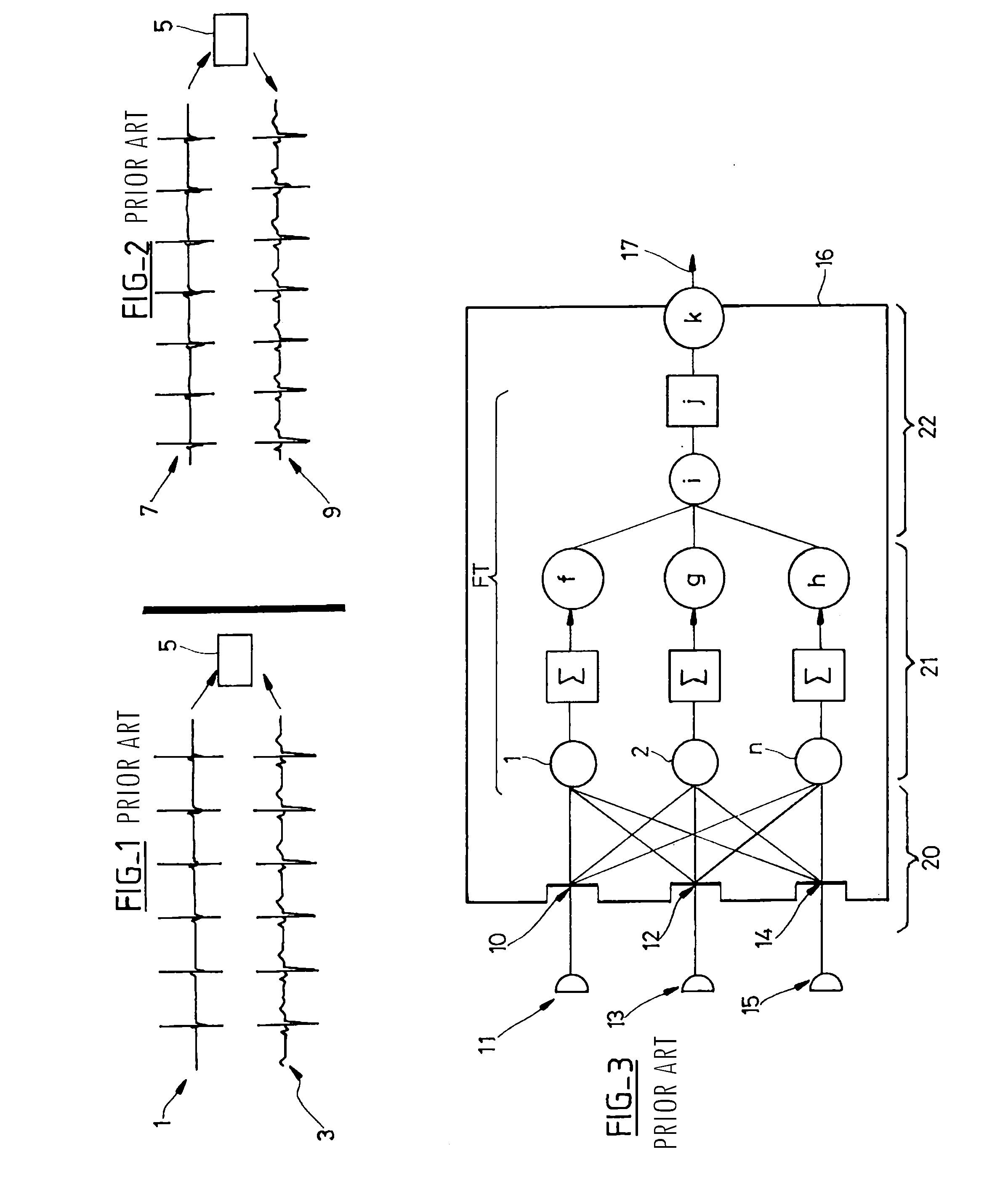Reconstruction of a surface electrocardiogram from an endocardial electrogram using non-linear filtering
a surface electrocardiogram and endocardial electrogram technology, applied in the field of implantable medical devices, can solve the problems of less rigorous follow-up of patients, less useful display of egm signals for practitioners who interpret ecg signals, and inability to reliably solve the problem of insufficient robustness
- Summary
- Abstract
- Description
- Claims
- Application Information
AI Technical Summary
Benefits of technology
Problems solved by technology
Method used
Image
Examples
first embodiment
[0048]Referring to FIGS. 4, 5 and 6, three alternative embodiments of neural networks in accordance with the present invention are schematically represented. FIG. 4 illustrates a first embodiment wherein a single derivation 31 delivers an EGM1 signal to networks 41, 42, . . . 52. Each of these networks 41, 42, . . . 52 uses its transfer function FT1, FT2, . . . FT12 to deliver as output reconstructed signals ECG1, ECG2 . . . , ECG12, each output corresponding to one of twelve external ECG derivations. In this embodiment, network 41, 42 . . . 52 run in a SISO (“Single Input Single Output”) system.
second embodiment
[0049]FIG. 5 illustrates a second embodiment wherein a plurality of EGM1′, EGM2′ and EGM3′ signals collected from distinct derivations 31′, 32′ and 33′ is processed by each network 41′, 42′ . . . 52′, using its transfer function FT1′ FT2′ . . . FT12′ to provide as outputs reconstructed signals ECG1′, EGC2′ . . . and ECG12′, each corresponding to one of twelve external ECG derivations. In this embodiment, each of these networks 41′, 42′ . . . 52′ operates on a MISO (“Multiple Input Single Output”) system.
third embodiment
[0050]FIG. 6 illustrates a third embodiment, a plurality of EGM1″, EGM2″ and EGM3″ signals collected from distinct derivations 31″, 32″ and 33″ is processed by a network 41″ using its transfer function FT to provide as output reconstructed signals ECG1″, ECG2″ . . . ECG12″, each corresponding to one of twelve external ECG derivations. In this embodiment, the network 41″ operates in a MIMO (“Multiple Input Multiple Output”) system.
[0051]According to one embodiment of the present invention, each of these embodiments of networks 41, 42 . . . , 52 (FIG. 5); 41′, 42′ . . . , 52′ (FIGS. 6), and 41, 42″ . . . 52″ (FIG. 7), is of a time-delay type, for example, as described with reference to FIGS. 7 and 8. Time-delay network 60 of a recurrent type as shown in FIG. 7 comprises:[0052]inputs 61, 62 and 63 receiving EGM signals collected on different derivations 71, 72 and 73;[0053]recurrent connections 85, receiving signals processed by the hidden layer of the network 60;[0054]buffers 64 intro...
PUM
 Login to View More
Login to View More Abstract
Description
Claims
Application Information
 Login to View More
Login to View More - R&D
- Intellectual Property
- Life Sciences
- Materials
- Tech Scout
- Unparalleled Data Quality
- Higher Quality Content
- 60% Fewer Hallucinations
Browse by: Latest US Patents, China's latest patents, Technical Efficacy Thesaurus, Application Domain, Technology Topic, Popular Technical Reports.
© 2025 PatSnap. All rights reserved.Legal|Privacy policy|Modern Slavery Act Transparency Statement|Sitemap|About US| Contact US: help@patsnap.com



